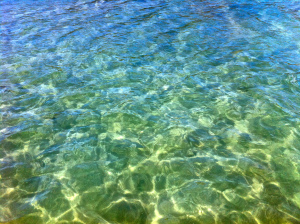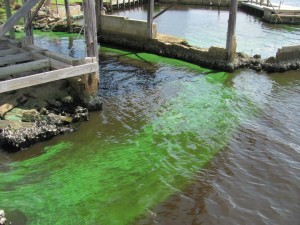
Clear beautiful water off the Sandbar, Stuart; but is safe to swim? (Photo by Jacqui Thurlow-Lippisch, St Lucie River/Indian River Lagoon, 2012)
Enterococcus: Bacteria normally found in the feces. Two types, Enterococcus fecalis and Enterococcus fecium, cause human disease, most commonly in the form of urinary tract and wound infections. Other infections, including those of the blood stream (bacteremia), heart valves (endocarditis), and the brain (meningitis) can occur in severely ill patients in hospitals. Enterococci also often colonize open wounds and skin ulcers, and are among the most common antibiotic-resistant bacteria. Medicine-Net
*The Martin County Health Department tests for Enterococcus (E) in area waters: According to their interpretation, 0-35 cfu of E./100 ml river water =GOOD; 36-104 cfu E/100 ml river water=MODERATE; and 105 cfu E./ml River water is POOR (“cfu” relates to number of viable cells per milliliter.)
River Testing
In November 2012, some members of the public were worried that the Martin County Health Department (MCHD) did not have enough support. Due to the pushing of a few members at a Rivers Coalition meeting, Senator Joe Negron, during the legislative budgeting process, added specific funding for MCHD to sample three new sites weekly. In turn, with input from the Rivers Coalition and the help of Bob Washam of the MCHD, the three test locations were chosen and the public began regularly checking bacteria levels in the St Lucie River/Indian River Lagoon on the MCHD website.
Before the senator intervened, the sites being tested in the river were the Roosevelt Bridge; the Jensen and Stuart Causeways, and the north fork of the St Lucie River in St Lucie County.
New Test Sites
The new test sites included Bessey Creek, close to the mouth of the C-23 canal, in Palm City; Leighton Park, at the base of the Palm City Bridge; and Sandsprit Park, near the Manatee Pocket in Stuart, close to the inlet. The Department of Environmental Protection also conducted/s periodic testing.
High Bacteria Levels
In early June of the 2013, the bacteria numbers really spiked. This occurred after heavy rains caused storm water to run through local canals C-23, C-24, and C-44 into the river, as well as polluted fresh water discharges from Lake Okeechobee through C-44, that had begun on May 8, 2013 by the Army Corp of Engineers.
The areas waters were looking dark and ugly, and most of the river was off limits to the public due to high Enterococcus levels. By mid June, there were a number of reports from people that had visited the Sandbar, located just inside the mouth of the St Lucie Inlet, that they and their children were feeling ill with stomach aches and diarrhea after contact with the water.
Because of the popularity of the Sandbar area and the complaints to the health department, Bob Washam, MCHD, together with Mark Perry, of Florida Oceanograpic, decided to drop the Bessey Creek site and change testing to the Stuart Sandbar. When the tests came back, the Sandbar reading was a high 192 cfu/100 ml river water/or POOR. So signs were posted at the Sandbar, at the height of the summer season; it was off limits to the public. Shocking.
Test Level Comparisons
Just for comparison, I am going to share the highest readings at the other sites in June and July of 2013. The highest readings were as follows: Roosevelt, 1620 cfu; Sandsprit, 640 cfu; Leighton, 3020 cfu; and Bessey Creek, 1560 cfu. As mentioned about 105 cfu per 100 ml of river water is considered POOR.
For a comparison to “today,” the latest readings on April 21, 2014 were: Roosevelt, 58 cfu; Sandsprit, 7cfu ; Leighton Park, 94 cfu and the Sandbar, 30 cfu . So even without super heavy rains or releases from Lake Okeechobee, readings can be moderate to borderline poor. (The Leighton site had been in the poor range just a few just weeks ago but is coming down…)
It is important to know that bacteria levels are absolutely exacerbated by the releases from Lake Okeechobee that bring in polluted fresh water from outside of our basin as far away as from Orlando, but Lake Okeechobee is not the only cause. Local canals’ runoff, poorly cared for septic tanks, farm and domestic animals, along with other sources in both Martin and St Lucie Counties, even Okeechobee, anywhere water runs into our rivers from a basin, play an important role in the bacteria water puzzle.
To understand the sources of fecal pollution, Martin County is presently conducting a water quality monitering study in partnership with Florida Atlantic University’s Harbor Branch. The study is tracking DNA results leading “back,” through attachment to isotopes, to either human, cow, horse, dog and/or bird feces.
At this point, studies are inconclusive, and helpful data is not expected until rainy season begins June 1st through November 30th.
We can’t dream that things here in Stuart used to be “perfect.” When I was a kid growing up in Martin County in the 60s and 70s there were some businesses that legally dumped their raw sewage into the St Lucie River and boaters were allowed to dump waste straight into the river. There were fewer people here then, yes, but it is still disgusting by today’s standards. I grew up swimming and water skiing in these waters. I never got sick and back then no one was monitoring the bacteria in the river
In conclusion, we don’t need to panic, we just need to be careful, and to be thankful for the progress we have made; most important, we must continue to improve the situation and “fix it.”
We ask that you contact your local, state and federal elected politicians and ask them to support efforts that will help keep our rivers and the Everglades clean, safe and healthy.
To check bacteria levels, visit the Martin County Health Department’s website and look for “river and beach water sampling results.”
About the author, Jacqui Thurlow-Lippisch, has been a defender of river health in the St Lucie River/Indian River Lagoon for many years and is a member “Rivers Coalition Defense Fund”. The Defense Fund helps promote the health and ecological balance of the St. Lucie River Estuary and Indian River Lagoon.
Jacqui may be reached at her website blog; www.jacquithurlowlippisch.com
A special thank you to Bob Washam, formerly of the MCHD, for his years of dedication and for his help with composing specifics of this article.
The above information is opinion based except where noted. Always contact a licensed professional for information on the above subject or BEFORE applying or practicing the above information.
HealthyMartin.com is designed to assist you in finding medical doctors, dentist and alternative, organic & holistic health in Martin County, St. Lucie, Indian River and the Palm Beaches. “Healthy Martin, working together for health choices for you, your family and friends”.


 Click On Above Ad to Go To Website
Click On Above Ad to Go To Website

